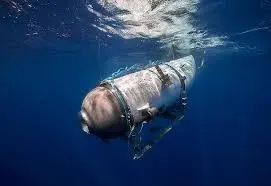Breaking News
[REVEALED] Titanic submersible tragedy: All you need to know
Titan had an estimated 96 hours of oxygen when it began its descent. A Canadian P-3 aircraft detected banging sounds in the search area two days after the vessel lost contact with its mothership. However, attempts to locate the source of the sound were futile. More vessels were deployed, and authorities began a frantic search for Titan.

The submersible Titan, which was sent to explore the ruins of the Titanic ship on June 18, lost contact with its mothership less than two hours into the eight-day journey and went missing with all five passengers on board. The passengers were confirmed dead after four days of searching, with the US Coast Guard citing a “catastrophic implosion” as the cause of death.
The Titan submersible, according to THE PUNCH, can accommodate up to five passengers, including a pilot and four crew members.
The submersible, which resembles a small fish-shaped car, is a vehicle that can function underwater. It does not rely on another vessel for power or air supply like a submarine does because it has its own system for replenishing oxygen.
Submersibles are used for a variety of underwater tasks such as oceanography, exploration, archaeology, and underwater equipment maintenance. They can also be used to film underwater.
The Royal Mail Ship Titanic was built to accommodate up to 3,320 people on a single voyage. Five men were planning to explore the wreckage of the Titanic, which sank over 100 years ago in Canada.
Despite being regarded as “unsinkable,” the Titanic collided with an iceberg and sank in the Atlantic Ocean during its maiden voyage in April 1912, killing approximately 1,500 people. The wreckage is located approximately 400 miles off the coast of Newfoundland, Canada, at a depth of 12,500 feet. The ship’s bow and stern are over 2,600 feet apart and are surrounded by debris.
The Titan submersible was carrying five people, including Stockton Rush, the CEO of OceanGate, Hamish Harding, a prominent businessman from Britain, Paul-Henri Nargeolet, a French diver, and Shahzada Dawood and his teenage son Suleman.
Nargeolet had made over 35 trips to the Titanic wreckage. Since the Titanic sank, it has become a popular destination for explorers and tourists who want to uncover the mystery behind the ship.
In 1985, oceanographer Robert Ballard led the first successful expedition to the wreckage using a submersible sled called Argo. RMS Titanic Inc., a tourism company, has led eight expeditions to the Titanic and auctioned off over 5,000 items recovered from the wreckage, including jewellery and a section of the ship’s grand staircase. Numerous researchers, salvagers, and filmmakers have visited the wreck, including James Cameron, who directed the 1997 film Titanic. Tourists can also visit the site for a fee.
The diving tour company, OceanGate, charged $250,000 per passenger for the trip to the historic Titanic site. However, court records show that the company had mechanical issues that caused previous trips to be cancelled or delayed.
Other expeditions were also delayed after OceanGate was forced to rebuild the Titan’s hull due to “cyclic fatigue,” which prevented it from reaching the wreckage. This information is from a report in 2020.
David Lochridge, who worked as an independent contractor for OceanGate in 2015 and as an employee from 2016 to 2018, expressed concerns about the Titan’s hull. He claimed that no non-destructive testing had been performed on the hull to look for issues such as delaminations, porosity, and voids of sufficient glue adhesion.
OceanGate sued Lochridge in 2018 for allegedly sharing confidential information. Two former OceanGate employees also expressed safety concerns about the submersible’s hull thickness. The Manned Underwater Vehicles committee of the Marine Technology Society expressed safety concerns in a letter to the company about its “experimental approach” to the Titan vessel and its planned expedition to the Titanic wreckage.
Despite thousands of years of exploration, only 20% of the ocean floor has been mapped, and most of it has never been seen by humans. Experts claim that travelling to the depths of the ocean is more difficult than going to space. Only three people have spent around three hours exploring the Challenger Deep, the deepest known point of the Earth’s seabed. This is due to the immense pressure that intensifies as you go deeper, making it a highly risky undertaking. The environment is shrouded in darkness, and the cold is extreme. The Hadal zone is the deepest part of the Earth’s oceans and is named after Hades, the Greek god of the underworld. The same factors that made the Titanic wreckage hard to find also make it almost impossible to explore the ocean floor.
Titan had an estimated 96 hours of oxygen when it began its descent. A Canadian P-3 aircraft detected banging sounds in the search area two days after the vessel lost contact with its mothership. However, attempts to locate the source of the sound were futile. More vessels were deployed, and authorities began a frantic search for Titan.
Rescue workers discovered what they thought to be Titan-related debris on Thursday evening close to the Titanic. Tests revealed that the debris was from the Titan’s hull, despite the authorities’ continued optimism. OceanGate announced a few hours later that all of the passengers had passed away.
According to US coast guard member John Mauger, the submersible carrying five passengers experienced a “catastrophic implosion,” killing everyone on board.




















